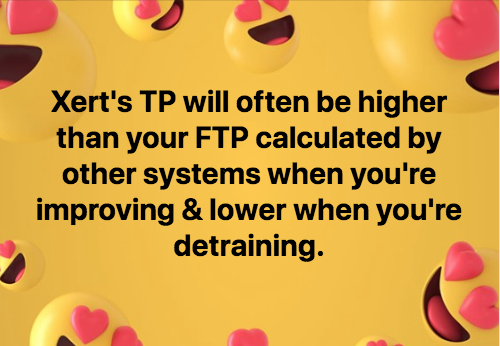Xert’s TP will often be higher than your FTP calculated by other systems when you’re improving & lower when you’re detraining.
What is this FTP you speak of?

Does TP have a practical interpretation or should it be understood as a model parameter?
I tend to ignore TP and instead use predicted critical power numbers to figure out Xert’s current opinion of me.
TP is the threshold where a intensities above it reduce MPA and intensities below it allow MPA to recover. In principle it works like CP/W’ with the distinction that using W’ is rate limited by MPA. The generalized method to calculate CP (and hence W’) does not incorporate this rate limit. In the calculation of CP, you’re able to sprint at your peak power at any given point of fatigue until W’ is used up. Having this in the calculation of CP, makes it different than TP.
That’s a very nice comparison between Xert’s model and CP/W’.
I actually didn’t have CP/W’ in-mind when I posted above. I was actually thinking about the MMP for various durations (which for some reason I’ve always called CP).
I need to make some flash-cards to get my terms right once-and-for-all.
No worries. CP and W’ go hand-in-hand. Exhaustive efforts above CP are often referred to as CP5 for your best 5 minute power or also your 5 minute mean maximal power or 5 minute MMP. In the CP/W’ model your 5 minute power = CP + W’/(5 minutes * 60s). Thus if your CP is 300 and your W’ is 24000J, your CP5 = 300 + 24000/300 = 380W. The inverse is how CP is calculated only it uses multiple points to calculate (or estimate) CP and W’.
However and notably, your 5 minute power calculated by Xert is not TP + HIE*1000/300. It is less than that because MPA gets in the way of you using up all HIE. This makes CP slightly higher than TP and W’ slight lower than HIE (in joules). Note that this discrepancy is not what this post is about.
can someone please help me to understand what “rate limited” means? I read this 10x but it’s not sinking into my brain.
(I know this is an old thread but I was about to post ~ this exact question…wondering the difference between CP/W’ and Xert’s model of TP/HIE. I just read Skiba’s book and in his chapter about W’ the whole time I am reading it I was thinking, “that’s super similar to what Xert does but real-time and without massive spreadsheets”)
Some of the literature talks about “rate limited”. In actual fact, this is analogous to MPA. (Rate at which W’ can be used is limited, i.e. power, i.e. MPA).
W’ can be fully used up with any intensity in the CP/W’ model whereas in Xert’s model, MPA forms the upper limit at which it can be used. In concept, failure is defined when power reaches MPA in the Xert model whereas W’ (i.e. W’bal) reaches 0 in the CP/W’.
Mathematically, the CP/W’ model is flawed since you can expend all W’ at an intensity far above CP (say 500W) but once W’ is exhausted you cannot do more the CP. In reality though, once you reach exhaustion, you can still go above CP, just not above a certain value. In the CP/W, you’d could only do CP after a 500W effort to exhaustion. In Xert, you could only do 499W and this rapidly declines as you try and sustain the effort. Exhaustion is a process and not a discontinuous drop in power. If you examine your data closely, you’ll see this happening over and over.
